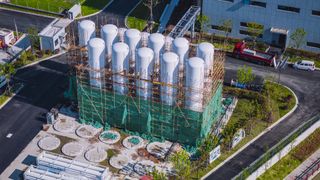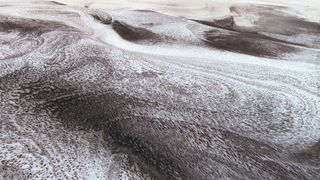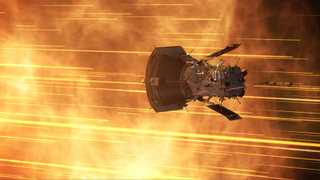The sun started 2025 with a bang as it fired off a powerful solar flare this morning. The X-class solar flare peaked at an X.12 at 6:40 a.m. EST (1140 GMT) on Friday (Jan. 3), releasing a blast of energy from a sunspot region known as AR 3947 and triggering a radio blackout event for parts of the Southern Atlantic, Africa and parts of eastern South America. When these blackouts happen, they can result in a full or partial loss of high frequency (HF) radio signals in regions that are…
Read MoreTag: Solar System
‘Ambitious climate action is more urgent than ever:’ 3 Climate records broken in 2024
The year 2024 has been another challenging one for Earth’s climate, marked by record temperatures, extreme weather events, and urgent warnings from scientists about the accelerating pace of global warming. An analysis by the Copernicus Climate Change Service (C3S), the European Union agency that tracks global warming, suggests this year will be the hottest since instrument record keeping began more than a century ago — beating climate records set just last year. 2024 will also be the first calendar year in which the global average temperature exceeded 1.5 degrees Celsius…
Read MoreGet ready for the ‘New Year Comet’: What to expect from Comet ATLAS (C/2024) G3
In the second week of 2025, we could see a new object grace the skies as comet ATLAS (C/2024) G3 gets close to the sun. In the wake of comet C/2023 A3 (Tsuchinshan–ATLAS) in October, comet G3 is due to reach perihelion — its closest to the sun — on Jan. 13, 2025. That day, this icy visitor to the inner solar system will get to within just 8.3 million miles (13.5 million kilometers) from the sun. For context, Mercury orbits the sun from as close as 29 million miles…
Read MoreChristmas solar flares erupt from the sun. Will they trigger aurora ‘fireworks’ as we close out 2024?
In the final hours of Christmas Day, the sun fired off four solar flares within less than three hours. The biggest flare of the series, recorded at a M7.3, erupted from sunspot region AR3938 on Dec. 25 at 10:15 p,m. EST (0315 GMT on Dec. 26). Solar flares are ranked and categorized by their power on a 4-level classification scale, with M-class the second strongest to the beastly X-class at the top. According to Spaceweather.com, this was part of a group of four different flares that happened within two and…
Read MoreScientists await signal from NASA’s Parker Solar Probe after historic close sun flyby. Will it phone home?
On the heels of a NASA spacecraft’s historic close flyby of the sun on Christmas Eve, scientists on Earth have one question on their minds: Did their probe survive as an epic Christmas gift, or is it a burned up lump of coal in space? For a few days, they simply won’t know, at least not until the spacecraft — NASA’s Parker Solar Probe — phones home with a simple “status beacon” on Friday (Dec. 27) to let its science team know it’s okay. But scientists behind the spacecraft’s sun…
Read MoreJust a fraction of the hydrogen hidden beneath Earth’s surface could power Earth for 200 years, scientists find
A mountain of hydrogen is lurking beneath Earth’s surface — and scientists say that just a fraction of it could break our dependence on fossil fuels for 200 years. New research suggests the planet holds around 6.2 trillion tons (5.6 trillion metric tons) of hydrogen in rocks and underground reservoirs. That’s roughly 26 times the amount of oil known to be left in the ground (1.6 trillion barrels, each weighing approximately 0.15 tons) — but where these hydrogen stocks are located remains unknown. Most of the hydrogen is likely too…
Read MoreMars orbiters witness a ‘winter wonderland’ on the Red Planet (photos)
Hoping for a white Christmas this year? Well, even if there’s no snow where you live, at least you can enjoy these images of a “winter” wonderland on Mars. Taken by the German-built High Resolution Stereo Camera (HRSC) on the European Space Agency’s (ESA) Mars Express orbiter in June 2022, and by NASA’s NASA’s Mars Reconnaissance Orbiter using its High-Resolution Imaging Science Experiment (HiRISE) camera on September 2022, these images showcase what appears to be a snowy landscape in the Australe Scopuli region of Mars, near the planet’s south pole.…
Read More10 most powerful solar flares of 2024
It’s been a busy year on the sun, as it officially entered the peak of its roughly 11-year cycle of activity, known as solar maximum. In 2024, the sun launched over 50 X-class solar flares — the most powerful type of solar flare — at Earth. Solar flares are categorized by the level of X-rays they produce in a specific wavelength range (1 to 8 angstroms). Solar flare classes follow a logarithmic scale, with each flare class — C, M and X — 10 times stronger than the previous one.…
Read MoreWhat time is the NASA Parker Solar Probe’s closest sun flyby ever on Christmas Eve?
A NASA spacecraft is about to give astronomers an epic early Christmas present with the closest ever flyby of the sun on Dec. 24, but if you’re wondering exactly when the ambitious solar encounter will occur, don’t worry. We’ve got you covered. The NASA spacecraft, called the Parker Solar Probe, is on course for what will be a record-setting close flyby of the sun on Christmas Eve, when it will fly through the star’s outer atmosphere at 6:53 a.m. EST (1153 GMT) and pass within 3.8 million miles (6.1 million…
Read MoreNASA Mars probe spies dusty, retired Insight lander from orbit (photo)
NASA’s InSight lander continues to contribute valuable knowledge about Mars, even after its retirement. Photos captured in late October by NASA’s Mars Reconnaissance Orbiter (MRO) show InSight resting on the Martian surface. While no longer active, the rover is providing researchers new data on how dust accumulates and evolves over time in the region. “Even though we’re no longer hearing from InSight, it’s still teaching us about Mars,” science team member Ingrid Daubar of Brown University said in a Dec. 16 NASA statement. “By monitoring how much dust collects on…
Read More








